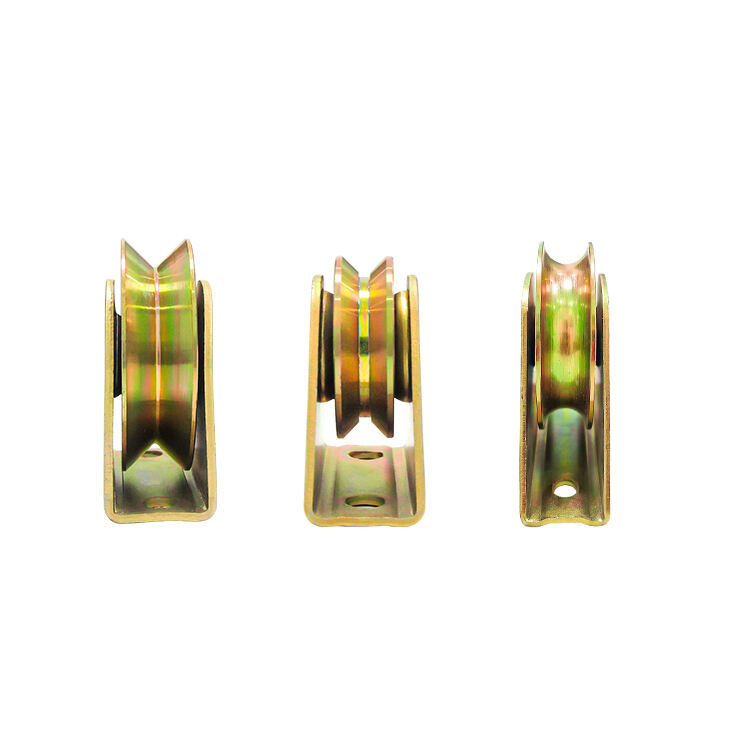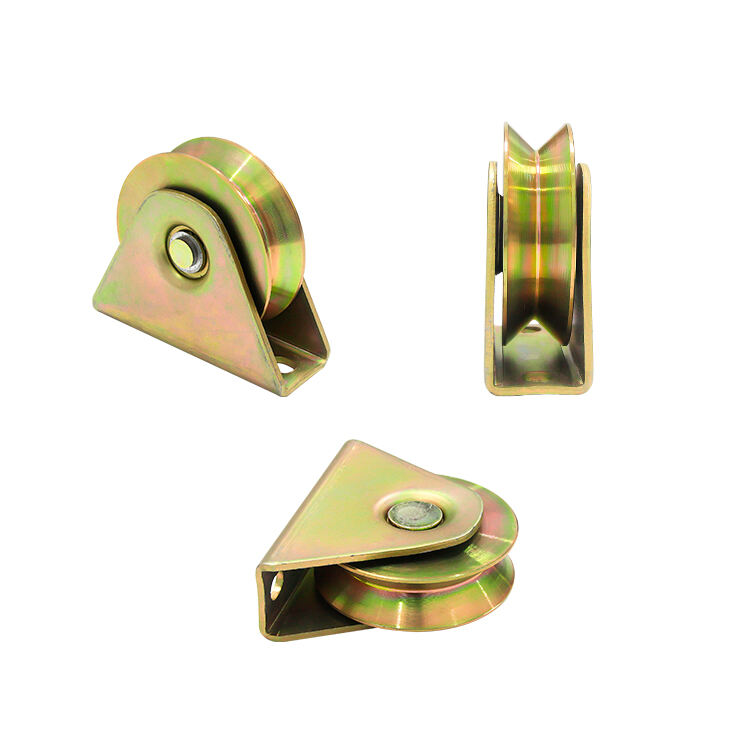Key Differences Between 2-Wheel and 4-Wheel Sliding Door Rollers
Load Capacity and Weight Distribution
Picking out sliding door rollers means looking at how much weight they need to carry and where that weight is distributed across the door. Most folks go for 2 wheel models when dealing with light doors around homes since these don't really need anything too robust. On the flip side, commercial buildings tend to use 4 wheel systems because they're made for much heavier loads. The extra wheels spread out the pressure better which helps support those big industrial doors without breaking down so quickly. Getting this wrong though? Well, mismatched rollers will start wearing out faster than expected and might even break completely after some time, so knowing what kind of door we're talking about makes all the difference in getting something that lasts.
Stability and Smooth Operation
When it comes to staying stable and running smoothly, four wheel rollers definitely come out on top. These rollers spread out the door weight across four different spots which cuts down on tipping around and those annoying wobbles we all hate. The way they're designed really helps things move along better, even if the floor isn't completely flat. That's why many people find them especially helpful in places where doors need to work consistently day after day without any hiccups. Some studies show folks actually run into fewer jams and get much smoother transitions with these four wheel systems compared to basic two wheel versions. For anyone looking at installations where everything needs to glide effortlessly with almost no resistance, going with four wheels just makes sense from both a practical standpoint and long term reliability perspective.
Space Requirements and Track Compatibility
When picking out sliding door rollers, space constraints and track compatibility really matter. Two wheel models tend to work better in tight spots since they take up less room and need simpler tracks for installation. Four wheel options usually demand wider tracks because they just plain occupy more space. This becomes super important when working with limited square footage. Getting the right match between roller type and track size matters a lot for proper installation. If there's a mismatch, things get complicated fast during setup and might affect how well the whole sliding door system actually works in practice.
Maneuverability in Different Environments
Two wheel rollers really shine when space is limited, which makes them go-to options for homes and small commercial spaces where getting around narrow doorways matters most. The way they're built lets operators pivot and change direction quickly something that comes in handy when working in cramped quarters. Four wheel models tell a different story though. These work best in big open areas where keeping things steady takes priority over quick turns. Think industrial warehouses or large retail stores with wide entry points that need solid support over longer spans. When picking between these options, it pays to look closely at what the space actually needs. A good installer will assess factors like traffic patterns, door size, and how often the equipment moves through the area before recommending one system over another. Getting this right from the start saves headaches down the road and keeps operations running smoothly year after year.
Pros and Cons of Each Configuration
2-Wheel Rollers: Lightweight and Cost-Effective
Many folks choose 2 wheel rollers when installing sliding doors at home because they cost less upfront. The fact that these rollers are light makes them cheaper to produce and easier to put in place since the door frame doesn't need extra reinforcement. But there's a catch. These rollers can't handle much weight, which becomes a problem with heavier doors. Plus, they need checking and adjusting more often than four wheel models do. Still, if money is tight and the door isn't too heavy, some homeowners find value in going with two wheel options even though they know the roller will probably need replacing sooner rather than later.
4-Wheel Rollers: Heavy-Duty and Reduced Friction
On the flip side, four wheel rollers work best when things get serious, especially for those big commercial doors that just won't tolerate any kind of failure. These rollers cut down on friction quite a bit during operation, so they tend to last much longer before needing replacement. Sure, the price tag is bigger at first glance compared to other options, but most companies find that the money saved over time through less frequent repairs and parts changes makes up for it. Many warehouse managers report that switching to these heavy duty systems means fewer headaches during peak hours when every second counts. The extra investment pays off in ways that go beyond simple math calculations.
Applications for Automatic Sliding Gate Openers
When it comes to automatic sliding gate openers, most homes go with 2-wheel rollers because they fit within tighter budgets and work fine for lighter gates. Commercial properties tell a different story though. These places typically install 4-wheel systems since they offer much better stability over time and don't wear out as quickly when dealing with those heavy industrial gates. Before making a decision between these options, property owners need to look at several factors. Weight capacity matters obviously, but so does how frequently the gate will be used daily. Someone installing a gate at their weekend cabin might get away with cheaper 2-wheel setup, while a business needing constant access would definitely want something more durable. The right choice ultimately depends on balancing initial costs against long term reliability issues down the road.
For further exploration of these options, you can delve into products such as sliding door rollers, featuring both 4-wheel and 8-wheel configurations. For more details, feel free to [check out Sliding Door Rollers 4/8 wheels](#).
Factors to Consider When Choosing Sliding Door Rollers
Door Weight and Material Composition
Picking out sliding door rollers starts by getting to know how heavy the door is and what it's made from. Big heavy doors constructed from thick wood or metal need stronger roller setups, usually going for four wheel models so they actually slide without getting stuck. Different materials affect how well rollers work because of where the weight sits and how balanced everything is. Take glass doors for example they tend to spread their weight around differently compared to solid wooden ones which changes what kind of rollers we should install. Nobody wants their door jamming up or wobbling all over the place, so matching the right rollers to the specific door material makes all the difference in avoiding headaches down the road.
Frequency of Use and Maintenance Needs
How often a door gets opened and closed makes a big difference when choosing the right kind of rollers for installation. Doors that see constant action need rollers built to last longer and create less friction, like those four wheel models that don't wear out so quickly. Two wheel rollers tend to take more beating during normal daily operations, which means they usually need fixing or replacing more often. Looking at how frequently the door will actually be used helps determine whether to go with two or four wheels, ultimately saving money on repairs down the road without compromising performance.
Integration with Electric Sliding Gate Systems
When picking out sliding door rollers, one thing worth paying attention to is how they work with electric systems such as sliding gate motors for smooth movement. Getting rollers that play nice with automatic sliding gate openers matters a lot because otherwise the whole setup might not function right together. Choosing the right kind of roller really affects whether an electric sliding gate works well or not, making all the difference in day to day use. To get things running smoothly, make sure the chosen rollers match up with what the electric sliding gate system requires, keeping everything working without hiccups throughout its lifespan.
Related Products
To delve deeper into roller systems suitable for various sliding door configurations, consider exploring products like the Sliding Door Rollers 4/8 wheels, 2pcs. This product offers versatility, coping effectively with doors up to 40kg. It is celebrated for its ease of installation and smooth operation, making it a popular choice.
- Sliding Door Rollers 4/8 wheels, 2pcs - Great for doors up to 40kg, ensuring easy setup and smooth tracking.
This information is vital for anyone considering roller options for doors integrated with electric or automatic systems, ensuring efficiency and reduced maintenance concerns.
Installation and Maintenance Tips for Optimal Performance
Aligning Tracks for Cantilever Systems
Getting those tracks properly aligned makes all the difference when it comes to how well cantilever sliding gates work day after day. When everything lines up just right, the gates move smoothly without getting stuck, which means less stress on the rollers and tracks themselves. That kind of alignment actually helps these components last longer since there's no extra friction wearing them down unnecessarily. Checking things out regularly for any signs of misalignment pays off big time because catching problems early stops small issues from turning into expensive fixes later on. Going the extra mile to get good quality materials for both tracks and rollers really matters too. Better materials stand up to daily use much better than cheaper alternatives, so they keep working reliably year after year. For anyone dealing with these gate systems regularly, taking care of alignment and material choices upfront saves headaches down the road.
Lubrication Techniques for Longevity
Keeping sliding door rollers properly lubricated helps them last longer and work better. For both 2 wheel and 4 wheel models, using the right kind of grease as recommended by the maker really cuts down on friction. This stops those pesky squeaks and jams that drive everyone crazy. How often to lube depends on how much the door gets used day to day. A good rule of thumb is to check every few months if it's only opened occasionally, but weekly maintenance makes sense for doors that see constant action. Setting up a regular schedule based on actual usage keeps everything running smoothly without turning into a chore nobody wants to do. Most people find that sticking to this routine saves time in the long run since they don't have to deal with emergency repairs later on.
Troubleshooting Common Roller Issues
Spotting those pesky roller problems early on makes all the difference in keeping things running smoothly. We're talking about jams, when rollers get stuck, misalignment where everything just doesn't line up right, or that annoying noise coming from somewhere nobody wants to hear it. Regular checkups and some basic maintenance work wonders in cutting down these headaches before they become big ticket repairs down the road. When someone takes the time to troubleshoot these issues, doors actually work properly which means happier customers since their sliding doors don't act up at inconvenient moments. The good news? Most folks can handle these fixes themselves with just a few simple tools around the house. Doors that open without drama day after day isn't just convenient it builds trust in the product long term.




